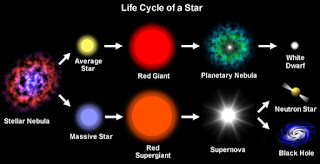Neptune is the eighth and the farthest known planet from the Sun in our Solar System. This is the fourth largest planet in terms of diameter and third largest in terms of mass. It's mass is 17 times than that if the Earth and slightly more than its twin planet, Uranus. Neptune is denser and physically smaller than Uranus because its greater mass causes more gravitational compression of its atmosphere. It is named after the Roman God of the Sea and has the astronomical symbol ♆, a stylised burning of the God Neptune's trident.
We can't see Neptune with our naked eyes and it is the only planet in the Solar System which is found using mathematical predictions and not by empirical observation. Neptune was visited by Voyager 2, when it flew by the planet on 25 August 1989; Voyager 2 remains the only spacecraft to visit Neptune. Physical Characteristics
Like Jupiter and Saturn, Neptune primarily consists of hydrogen and helium and traces of hydrocarbons and possibly nitrogen, though it contains a high proportion of "ices" such as water, ammonia an methane. Similar to Uranus its interior composed of ices and rocks and that's why Uranus and Neptune are called as "Gas Giants".
Its atmosphere forms about 5 to 10% of its mass and extends perhaps 10 to 20% of the way towards the core, about 10000 times of Earth's atmosphere. Higher concentration of methane and ammonia are found in the lowe region of the atmosphere. Neptune's mantle is rich in water, methane and ammonia and is equivalent to 10 to 15 Earth masses. This dense fluid, which has a high electrical conductivity is sometimes called a water-ammonia ocean. The methane decomposes into diamond crystals that rain downwards like hailstones at a depth of approximately 7,000 km(4350 mi). Scientists also believe that this kind of diamond rain occurs on Jupiter Saturn and Uranus also.
The core of Neptune is likely composed of iron, nickel and silicates, with an interior model giving a mass about 1.2 times that of Earth and has a temperature of approximately 5,400 K.
Atmosphere
Neptune's outermost atmosphere consists of 80% hydrogen and 19% helium, with trace amounts of methane. Neptune's atmosphere is subdivided into two main regions: the lower troposphere, where temperature decreases with altitude, and the stratosphere, where temperature increases with altitude. The boundary between the two is the tropopause. The stratosphere then gives way to the thermosphere and the thermosphere gradually transitions to the exosphere. Standard model suggests that Neptune's troposphere is covered with clouds of various compositions depending on altitude.

The upper level clouds are present where the temperature is suitable for methane to condense and clouds of ammonia and hydrogen sulphide are thought to form. After that clouds are made up of ammonia, ammonium sulphide, hydrogen sulphide and water. Deeper clouds of water ice should be found where the temperature reaches 273 K (0°C). Underneath, clouds of ammonia and hydrogen sulfide may be found. Neptune's spectra suggests that its lower stratosphere is hazy due to presence of of ethane and ethyne. The stratosphere is also home to trace amounts of carbon monoxide and hydrogen cyanide. The stratosphere of Neptune is warmer than that of Uranus due to the elevated concentration of hydrocarbons.
Magnetosphere
Neptune's Magnetic Field is similar to taht of Uranus which is strongly tilted relative to its rotational axis at 47° and offset at least 0.55 radii, or about 13,500 km from the planet's physical centre. Neptune Magneto sphere is populated with fewer protons and electrons per unit volume than that of any other Giant planet. Near the magnetic poles, the charged particles in the Magnetosphere can travel along magnetic field lines into the atmosphere.
Here are some of the important figures related to the planet Neptune:
1. Distance from Sun: 4.5 billion km (2.8 million mi)
2. Diameter: 49,244km (30,598 mi)
3. Gravity: 11.15m/s²
4. Solar day: 16 hours
5. Solar Year: 164.8 Earth years
6. Satellites: 14 known moons
7. Surface Area: 7.618 billion km²
8. Volume: 6.254*10¹³km³
9. Mass: 1.024*10²⁶ kg
10. Density: 1.64 g/cm³









Comments
Post a Comment